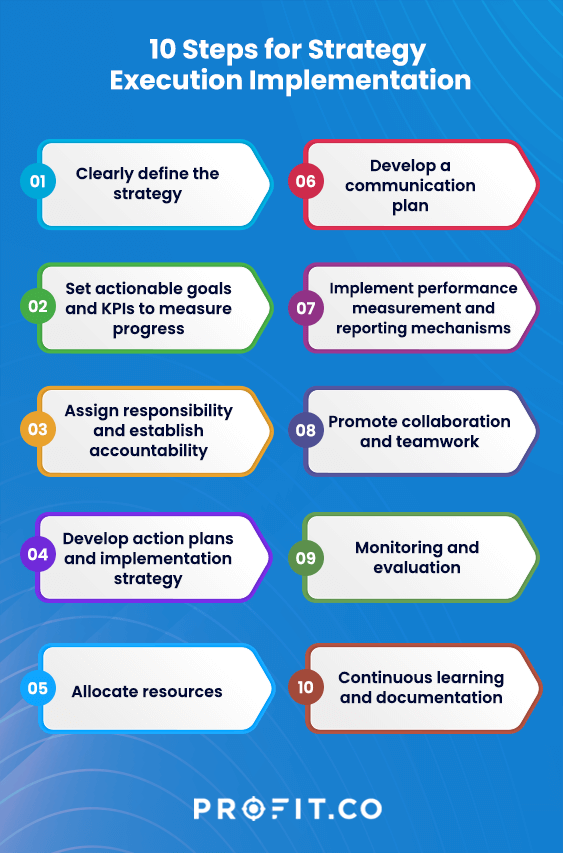Introduction
An organization is a massive functional structure that requires a vision and an overarching strategy to guide all its activities toward that vision. While having robust strategic plans is vital, the quality of the results and outcomes are determined by how well you implement those plans. So strategic execution implementation is crucial for the strategic success and achievement of the organizational objectives and vision.
In this guide, discover the steps and insights you need for a successful strategy execution implementation.
What is Strategy Execution Implementation?
Strategy execution implementation involves the processes, activities, and decisions that turn strategic plans into actions to achieve the desired objectives. It consists in translating the strategic vision into operational terms and guiding organizational efforts toward achieving these goals.
This process can include various elements such as setting clear objectives, developing a roadmap for achieving these objectives, aligning organizational resources (people, time, budget) to this roadmap, setting up performance metrics to monitor progress, and creating feedback systems to adjust the plan.
Every new change forces all the companies in an industry to adapt their strategies to that change.
A successful strategy execution implementation is one where the company’s vision is well-communicated and well-understood across all levels of the organization and where each individual understands their role in bringing that vision to life. Despite its importance, strategy execution implementation is often where many organizations need to improve, making it a critical focus area for leaders and managers.

10 Steps for Strategy Execution Implementation
Executing a strategy involves extensive planning, robust communication, and practical implementation. Following are the steps involved in strategy execution implementation.
1. Clearly define the strategy
The most critical components of a strategy are the vision, mission, objectives, and goals. You can adopt a strategy framework to define the strategy and ensure alignment of all its components with what you want to achieve as an organization. The company leadership and top-level management define the organizational strategy. However, the entire workforce of the organization carries out the strategy execution. So it’s crucial to communicate the strategy widely across the organization with all the stakeholders to create alignment, understanding, and acceptance.
2. Set actionable goals and KPIs to measure progress
Break down the strategic objectives into smaller, actionable goals that are specific, measurable, achievable, relevant, and time-bound (SMART). Goals become specific when you set a target number, percentage, or milestone. To make them measurable, you must establish key performance indicators (KPIs) to track progress against the goals and measure success. Goals become achievable when you set realistic targets for the given timeframe. They become relevant when you align them with strategic objectives; ensure that the goal achievement at every level adds to the strategic success. Goals should have deadlines, and long-term goals should have clearly defined milestones, which the responsible individuals and teams should meet according to the timeline.
3. Assign responsibility and establish accountability
Strategy execution requires teamwork, and various individuals and teams should be responsible for the execution of different aspects of the strategy. Assigning the right people with the right skillsets for every aspect of the strategy is essential. Clearly define the roles and responsibilities, identify and assign the most qualified and suitable individuals and teams, empower them with the decision-making authority within the ambit of their duties, and foster a sense of ownership and accountability among employees.
Ready to implement your business unit?
4. Develop action plans and implementation strategy
Create an implementation strategy that:
- Lists detailed action plans, specific steps, tasks, and activities.
- Outlines the strategic priorities
- Determines budget and other resources for those strategic priorities and the tasks and activities aligned with them
- Breaks down tasks into manageable sub-tasks and milestones with deadlines
- Draws a detailed timeline and schedule for various sub-tasks, tasks, and activities
5. Allocate resources
You must determine the priorities outlined in the implementation strategy and allocate resources, including financial, human, infrastructure, and technological resources required for completing the prioritized strategic initiatives.
6. Develop a communication plan
Communicating the strategy, strategic objectives, goals, and expected outcomes ensures teamwork and alignment at all levels of the organization. You must develop a communication plan that determines the channels you would use for communication, including one-on-one meetings, team meetings, emails, newsletters, internal social media platforms, etc. Your communication plan should encourage open communication, get feedback from all the stakeholders, address concerns and create a widespread acceptance of your strategy, the strategic objectives, and the implementation strategy.
7. Implement performance measurement and reporting mechanisms
Determine the frequency of performance measurement, progress tracking, and reporting. Implement a performance management system that allows employees to regularly update their progress against their respective goals and consolidate them to visualize progress at the individual, team, and organizational progress. It would allow you to track the progress of various strategic initiatives. Further, the system would automate data analysis and provide insights into the performance of the overall strategy execution.
8. Promote collaboration and teamwork
Executing strategy requires cross-functional collaboration and teamwork across the organization. Working in silos is one of the most prominent reasons for strategic failure in organizations. So it is essential to promote teamwork, knowledge-sharing, and cooperation among different departments and teams. Coordinating these teams and establishing teamwork mechanisms, such as regular meetings with concerned teams, shared goals, etc., is vital for facilitating cross-functional alignment and collaboration.
9. Monitoring and evaluation
You can periodically evaluate the effectiveness of your strategic initiatives and action plans and monitor the progress of the strategy execution implementation by tracking the performance against the KPIs established in the implementation strategy. Through regular monitoring and evaluation, you can identify the implementation gaps, identify bottlenecks, deviations, and lack of progress and make changes as needed to address them. Regular monitoring, evaluation, and course correction ensure continuous alignment with the strategic objectives and keep you agile and adaptable to changing market dynamics and emerging challenges.
10. Continuous learning and documentation
Strategy execution provides a continuous learning experience where you track progress, identify mistakes, and make constant improvements. It also lets you learn from your successes as well as your mistakes. You can invite employee feedback to get their insights, capture their experiences and learn about the best practices they adopted for effective strategic execution. You can consolidate the feedback and learning, document everything, and share them across the organization to create a culture of continuous learning at the organizational level and prepare the employees to identify opportunities and manage future challenges proactively.
FAQs
1. What is the difference between execution and implementation?
Strategy implementation and strategy execution are used interchangeably. However, there is a minor difference between the two. Implementation is preparing and organizing the necessary elements to execute a plan. At the same time, execution is actively carrying out the plan and achieving the desired results.
2. What are the four A’s of strategy execution?
The four A’s of strategy execution are:
- Alignment
- Accountability
- Action
- Assessment
3. What are the steps in strategy execution?
Strategy execution involves the following steps:
- Defining the strategy
- Setting goals
- Assigning responsibility and establishing accountability
- Developing action plans
- Allocating resources
- Developing a communication plan
- Implementing performance measurement and reporting mechanisms
- Promoting collaboration and teamwork
- Monitoring and Evaluation
- Continuous learning and documentation
4. What are the five stages of making and executing strategy?
The five stages of making and executing strategy are:
- Environment analysis
- Strategic planning
- Strategy formulation
- Strategy implementation
- Evaluation and control
Conclusion
Strategy execution implementation stands as the crucial bridge between visionary planning and tangible success. It transforms lofty ideas into actionable steps, aligning organizational resources and efforts toward a common goal. Yet, it remains a challenging endeavor, often overlooked or inadequately managed.
The path to mastering this art lies in understanding its core components by setting clear objectives, effectively aligning resources, diligently tracking progress, and being agile enough to make necessary adjustments. You can navigate the complexities of turning strategy into action by embedding these practices into your organizational fabric.
Iterating OKRs in your organization with Profit.co’s intuitive OKR software will help streamline your strategy execution implementation.

